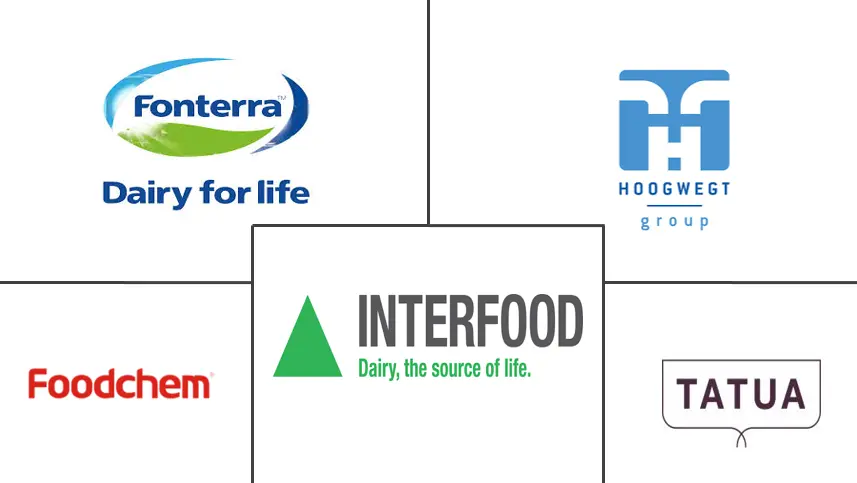Market Size of Asia-Pacific Dairy Protein Industry

| Study Period | 2019 - 2029 |
| Base Year For Estimation | 2023 |
| Forecast Data Period | 2024 - 2029 |
| Historical Data Period | 2019 - 2022 |
| CAGR | 5.20 % |
| Market Concentration | Medium |
Major Players
*Disclaimer: Major Players sorted in no particular order |
Asia-Pacific Dairy Protein Market Analysis
The Asia Pacific dairy protein market is projected to register a CAGR of 5.2%, during the forecast period.
- The market is majorly driven by the increasing health care awareness and consumer's preference toward nutritional and healthy diets in recent times. In addition, consumer perception of the high nutritional content of infant formula due to the health consciousness of their children drive the growth for infant formula consumption made from dairy proteins. Organizations such as FDA and dairy ingredient manufacturers are in R&D activities to enhance the properties such as flavor, aroma, and performance of dairy protein ingredients. This is anticipated to provide opportunities for manufacturers to offer an improved variety of dairy protein ingredients in the market to achieve a higher share.
- However, the rising adoption of veganism and high incidences of lactose intolerance are hampering the growth of the market. Additionally, fluctuations in raw material prices are a major challenge faced by the market players.
Asia-Pacific Dairy Protein Industry Segmentation
The Asia Pacific dairy protein market has been segmented based on the ingredients, applications, and geography. The ingredients segment consists of whey protein concentrates and isolates, milk protein concentrates and isolates, casein and caseinates, as the major products. Based on the application of dairy proteins, the various sectors are food & beverage, infant formulations, personal care, animal feed, and others. Also, the study provides an analysis of the dairy protein market in the emerging and established markets across the Asia Pacific, including China, Japan, Australia, India, and Rest of the Asia Pacific.
| By Ingredients Type | |
| Milk Protein Concentrates (MPCs) | |
| Whey Protein Concentrates (WPCs) | |
| Milk Protein Isolates (MPIs) | |
| Whey Protein Isolates (WPIs) | |
| Casein and Caseinates | |
| Others |
| By Application | |||||||
| |||||||
| Beverage | |||||||
| Personal care & Cosmetics | |||||||
| Animal Feed | |||||||
| Others |
| By Country | |
| China | |
| Japan | |
| Australia | |
| India | |
| Rest of Asia Pacific |
Asia-Pacific Dairy Protein Market Size Summary
The Asia-Pacific dairy protein market is experiencing steady growth, driven by increasing health awareness and a shift towards nutritional diets among consumers. The demand for dairy proteins, particularly in infant formulas, is bolstered by the perception of their high nutritional value, which is a significant factor for health-conscious parents. The market is also supported by ongoing research and development efforts by organizations like the FDA and dairy ingredient manufacturers, aiming to enhance the properties of dairy protein ingredients. However, challenges such as the rise of veganism, lactose intolerance, and fluctuations in raw material prices pose obstacles to market expansion. Despite these challenges, the market for whey protein concentrates is thriving, particularly in the sports nutrition and lifestyle sectors, with strong demand in countries like China.
China's robust consumer market is a key driver of the Asia-Pacific dairy protein market, with a growing appetite for dairy products such as yogurt and infant milk formula. The country's leading food companies, like Arla, report a significant consumption of yogurt among adults and children, indicating a strong market potential. The infant milk formula segment, in particular, has seen substantial growth, contributing significantly to the market's revenue. Companies are responding to this demand by offering differentiated dairy ingredients tailored to various applications, such as sports nutrition and fermented products. The competitive landscape of the market is characterized by numerous domestic and multinational players, with strategic mergers, expansions, and partnerships being common tactics to enhance market presence. Key players include Fonterra Co-operative Group, Hoogwegt, Interfood Holding, and Foodchem International Corporation, among others.
Asia-Pacific Dairy Protein Market Size - Table of Contents
-
1. MARKET DYNAMICS
-
1.1 Market Drivers
-
1.2 Market Restraints
-
1.3 Porter's Five Forces Analysis
-
1.3.1 Threat of New Entrants
-
1.3.2 Bargaining Power of Buyers/Consumers
-
1.3.3 Bargaining Power of Suppliers
-
1.3.4 Threat of Substitute Products
-
1.3.5 Intensity of Competitive Rivalry
-
-
-
2. MARKET SEGMENTATION
-
2.1 By Ingredients Type
-
2.1.1 Milk Protein Concentrates (MPCs)
-
2.1.2 Whey Protein Concentrates (WPCs)
-
2.1.3 Milk Protein Isolates (MPIs)
-
2.1.4 Whey Protein Isolates (WPIs)
-
2.1.5 Casein and Caseinates
-
2.1.6 Others
-
-
2.2 By Application
-
2.2.1 Food
-
2.2.1.1 Infant Nutrition
-
2.2.1.2 Dairy Based Food
-
2.2.1.3 Bakery, Confectionary and Frozen Desserts
-
2.2.1.4 Sports and Performance Nutrition
-
2.2.1.5 Others
-
-
2.2.2 Beverage
-
2.2.3 Personal care & Cosmetics
-
2.2.4 Animal Feed
-
2.2.5 Others
-
-
2.3 By Country
-
2.3.1 China
-
2.3.2 Japan
-
2.3.3 Australia
-
2.3.4 India
-
2.3.5 Rest of Asia Pacific
-
-
Asia-Pacific Dairy Protein Market Size FAQs
What is the current Asia-Pacific Dairy Protein Market size?
The Asia-Pacific Dairy Protein Market is projected to register a CAGR of 5.20% during the forecast period (2024-2029)
Who are the key players in Asia-Pacific Dairy Protein Market?
Fonterra Co-operative Group (NZMP), Hoogwegt, Interfood Holding, Foodchem International Corporation and The Tatua Cooperative Dairy Company Ltd are the major companies operating in the Asia-Pacific Dairy Protein Market.

